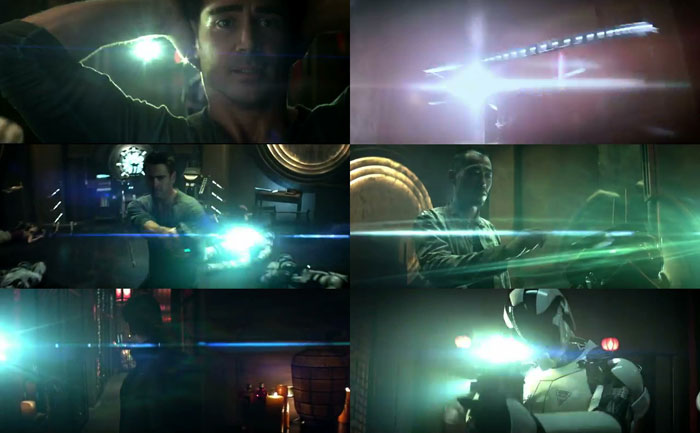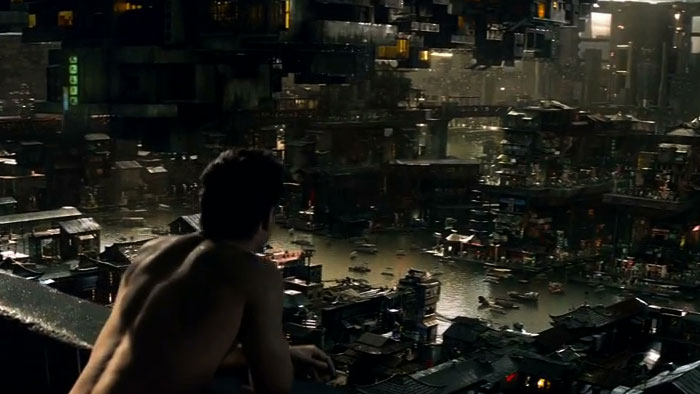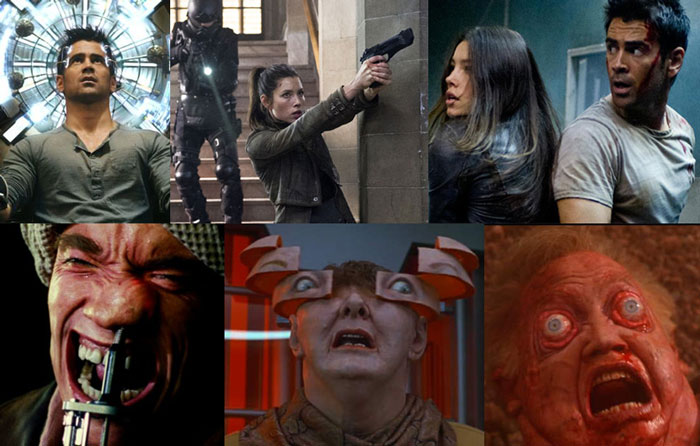Death to Lens Flares
I used to like lens flares. But after watching the 2012 remake of “Total Recall” (the boring CGI extravaganza starring some dude and Kate Whats-her-name) I just can’t stand them anymore. This movie is really shoving the OpticalFlares plugin into your face. It’s like an obnoxious mosquito in your room. STOP IT and get on with the plot already!

Oh. Right. Plot. That movie really has nothing else to offer but CG set extensions and optical flares.
Wait… what puts me into a position to criticize a movie that clearly has an audience? Me, who hasn’t even gone through script-writing classes? Well, as somebody who eats food I have a right to criticize a dish I didn’t like based on the fact that I’ve enjoyed a similar one in the past. I don’t have to be a cook myself 🙂 And since the internet is already full of movie criticism that nobody wants to read, I’m trying to blend some thoughts on look and VFX into my ramblings. So here we go.
If you freeze a single frame you can really see the hard work put in there by the VFX crew. I didn’t work on it but if it’s anything like the Hollywood shows I’ve worked on, it usually goes on and on like this for weeks:
Put some more sparks here, add a tiny glint over there.
Fix edge of hair on screen left.
Add more teeny-tiny holograms in the background that nobody’s gonna notice unless they print out single frames from the Blue-Ray and stare at them for a minute…

Awesome level of detail in Total Recall’s CGI set extensions (crop from HD trailer)
I can only image how many revisions the compositing artist made to the brightness of the roof to the left of Colin Farrell’s head until VFX supervisor and director were happy. 3? 5? But what good does this level of detail and photorealism do if somebody should have put more effort into script and characters instead?
I know, it’s a science-fiction movie. And the whole movie might be a dream anyways. But things like the elevator through the earth’s core or the floating buildings in the sky kept bothering me.
Questioning this kind of stuff isn’t really about questioning the thoughts that were put into a movie universe and its back story. Maybe it’s hinting at the fact that many look and set design decisions are an iterative process done in VFX postproduction (“hey, let’s put even more buildings into the background and make it look like they’re floating in the sky!”). There is one scene in Total Recall that shows how well it can work out when design decisions are rooted in the script instead: Quaid saves his life by disabling a robot soldier at lightning speed. He is able to loose two screws and rip out a circuit board in two seconds because he performed the reverse action for years while working at the robot assembly line.
But that’s not the point. Questioning sci-fi technology is more of a sign that what happens on screen just didn’t keep you engaged so your mind starts wandering. There are a lot of movie universes that I enjoy although their technology makes no sense if I start thinking about it for even a minute. The original “Total Recall” by director Paul Verhoeven is equally far out, but I can’t help but feel that Arnie’s Quaid/Hauser character was actually torn between what is true and what is just mindgames.
In 2012, Hauser/Quaid is just an underwear model being chased by a lingerie model through set pieces copied from other movies like “I, Robot” or “Minority Report”. Toned down for a PG-13 rating and the largest possible audience.
Just fire up an image search for “total recall” and compare the screenshots. Verhoeven’s version has left us with so many iconic images that still ring a bell 22 years later! Which of the top row of images will you recall in 2034?

In 1990 they weren’t afraid of saturated colors yet. 2012 is – of course – orange & teal.
To sum it up, “Total Recall (2012)” is boring stuff for guys like Mr Egan from the UK who shares this nugget in an IMDB review:
PS. How can a movie not have a 10/10 when it includes a woman with not Two but THREE whole breasts?
On my scale: 5/10 (the “mediocre waste of time but not horrible” level)
Trashy Rausgepustet
Hat mir neulich ein Kollege gezeigt:
Großartiges Buzzword-Bingo aus der VFX-Branche 🙂
Moving Heaven And Earth
This August, I’ve been working at Sehsucht Hamburg on a commercial for Dodge Ram. It’s online now so watch it in all its glory:
Amongst other things, I was responsible for compositing the shot of the car bursting through the dust cloud, wire removal work on the eagle shots and the night-time “pack shot” at the end.
Software used: Nuke, Mocha
Full credit list available here.
Here’s a small breakdown video:
[flowplayer src=’videos/ram_breakdown.mp4′ width=640 height=360 splash=’ram_breakdown.jpg’]
Rolling Shutter Update
I’ve just updated my rolling shutter removal Fuse for Fusion. It implements the technique used by Syntheyes, where the center scanline is assumed to have been taken at the current frame (instead of the topmost scanline).
Here’s a white paper that explains the technique, but most of it isn’t applicable to my Fuse. In fact, the author of Syntheyes advises against messing with your footage in order to remove the effects of rolling shutter. My Fuse isn’t intended to be used on raw footage (pre match moving). Instead, it’s a finishing tool to reduce/remove distorting in case your shot exhibits unwanted wobbling due to the rolling shutter issue.
VFX/Nuke Blog
I’ve just discovered that Jan Burda, a very talented compositing artist I’ve worked with in the past, has opened up his own blog. He has written some Nuke tutorials, so head over to his place and have a look!
Object Removal Video Tutorial
My next video tutorial for Fusion is online. It’s about removing objects (a shadow in this case) from a shot using a 3D matchmove, some scene geometry and automated white-balance matching. You can download the complete project and footage as well. Yeah, it’s a home video of mine but the technique has proven valuable on various shows already.
It can also be easily transferred to Nuke.
Related to this: freezing cameras for projection setups just got a whole lot easier with this script.
Also slightly related to this: on some other blog I’ve found a link to these vintage VFX educational videos. The whole thing has an 80s air to it but the names of the presenters should ring a bell 🙂 Well-known gurus like Ron Brinkmann and Stu Maschwitz are among them.
Object Removal Teaser
This is an old post. Head over to the final version of this tutorial.
I’m in the process of recording another video tutorial about camera projections. This time, I’ll demonstrate a real-life example of how to remove objects (a shadow on the ground in this case) from a shot. Ok, it’s a home video of mine, not a real shot from one of my projects. But I have employed this technique on actual shows and this shaky video of mine is much more challenging than a perfect film scan.
Here’s a preview: